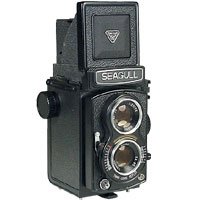Twin Lens Reflex Cameras
Seagull GC-104
The Seagull GC-104 has a lightweight design which consists of a waist-level finder with a pop-up magnifier, manual film wind advance and separate shutter speed and aperature levers and comes equipped with a built-in 75mm f/3.5 Seagull lens. There are some great features about this camera; for instance, it shoots in a 6x6cm format, the camera is supplied with a 6x4.5cm format mask which fits inside the camera and allows the photographer to obtain 16 exposures from 120 film. Another good camera feature is the mechanical lens shutter is designed to provide a flash synchronization at all speeds up to 1/3000 second and has a bulb exposure as well.
 Rolleiflex 4.0 FW
Rolleiflex 4.0 FWThe Rolleiflex 4.0 FW uses a 6x6cm format and has more than 4x the area of a 35mm camera. Instead of using a typical viewfinder, the Rolleiflex uses a ground-glass focusing system which gives a larger format feel when looking through the camera. The Rolleiflex also features a fold-away crank that moves the film with a quick swinging motion, while simultaneously cocking the shutter and advancing the frame counter. There are other features such as film speed adjustment that ranges from 25-6400 ISO, a cable release socket, high performance 50mm f/4.0 wide-angle lens, parallax correction, and interchangeable focusing screens.
 Single Lens Reflex CamerasHasselblad 503CW
Single Lens Reflex CamerasHasselblad 503CWThe Hasselblad 503CW has a compact, lightweight design with a built-in flash metering system, and is good for studio or location photography. Some other features of the Hasselblad are they have an acute-matte “D” focusing screen with microprism and split-image rangefinder spot and a gliding mirror system, which works well with longer lenses.
 35mm Camera
35mm CameraThe Nikon FM2 is just an example of a 35mm camera but there are many other types designed by Canon and Minolta. In particular, the Nikon 35mm cameras, have shutter speeds that range from 1 second to 1/4000 of a second including the bulb exposure as well. A 35mm camera is a good back-up camera because it is compact, light weight, battery powered, and can be taken outside of a studio easily.

http://www.bhphotovideo.com/


 Rolleiflex 4.0 FW
Rolleiflex 4.0 FW


 Santa Barbara Baltic Birch 4x5 Pinhole Camera
Santa Barbara Baltic Birch 4x5 Pinhole Camera
